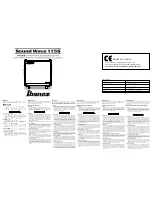
17. FULLY CLOSED LOOP SYSTEM
17 - 2
17.1 Functions and configuration
17.1.1 Function block diagram
A fully closed loop control block diagram is shown below. The fully closed loop system is controlled in the
load-side encoder unit.
Servo motor-side cumulative
feedback pulses
(load-side encoder resolution unit)
(Servo motor side)
Droop pulses
(Servo motor side)
Cumulative
feedback pulses
Load-side
droop pulses
Cumulative load-side
feedback pulses
Fully closed loop
dual feedback
filter
([Pr. PE08])
(Note 2)
FBD
Servo motor
Linear encoder
Controller
(Note 1, 2)
Fully closed loop selection
([Pr. PE01] and [Pr. PE08])
+
-
FBN
S
+
-
Encoder pulse setting
([Pr. PA15], [Pr. PA16]
and [Pr. PC03])
Fully closed loop control
error detection function
selection ([Pr. PE03])
+
-
+
+
-
+
-
+
Control
Monitor
Load-side feedback pulses
CDV
CMX
Electronic gear
Note 1. Switching between semi closed loop control and fully closed loop control can be performed by changing the setting of [Pr.
PE01].
When semi closed loop control is selected, a control is always performed on the bases of the position data of the servo
motor encoder independently of whether the servo motor is at a stop or running.
2. When the fully closed loop system is enabled in [Pr. PE01], dual feedback control in which the servo motor feedback signal
and load-side encoder feedback signal are combined by the dual feedback filter in [Pr. PE08] is performed.
In this case, fully closed loop control is performed when the servo motor is at a stop, and semi closed loop control is
performed when the servo motor is operating to improve control performance. When "4500" is set as the filter value of [Pr.
PE08 Fully closed loop dual feedback filter], fully closed loop control is always performed.
The following table shows the functions of each control mode.
Control Description
Semi closed loop control
Feature
Position is controlled according to the servo motor-side data.
Advantage
Since this control is insusceptible to machine influence (such as machine resonance),
the gains of the servo amplifier can be raised and the settling time shortened.
Disadvantage
If the servo motor side is at a stop, the side may be vibrating or the load-side accuracy
not obtained.
Dual feedback control
Feature
Position is controlled according to the servo motor-side data and load-side data.
Advantage
Control is performed according to the servo motor-side data during operation, and
according to the load side-data at a stop in sequence to raise the gains during operation
and shorten the settling time. A stop is made with the load-side accuracy.
Fully closed loop control
Feature
Position is controlled according to the load-side data.
Advantage The load-side accuracy is obtained not only at a stop but also during operation.
Disadvantage
Since this control is susceptible to machine resonance or other influences, the gains of
the servo amplifier may not rise.
Summary of Contents for MR-J4
Page 9: ...A 8 MEMO ...
Page 19: ...10 MEMO ...
Page 73: ...1 FUNCTIONS AND CONFIGURATION 1 54 MEMO ...
Page 155: ...3 SIGNALS AND WIRING 3 76 MEMO ...
Page 199: ...4 STARTUP 4 44 MEMO ...
Page 289: ...6 NORMAL GAIN ADJUSTMENT 6 24 MEMO ...
Page 335: ...8 TROUBLESHOOTING 8 8 MEMO ...
Page 357: ...9 OUTLINE DRAWINGS 9 22 MEMO ...
Page 517: ...12 ABSOLUTE POSITION DETECTION SYSTEM 12 30 MEMO ...
Page 617: ...16 USING A DIRECT DRIVE MOTOR 16 20 MEMO ...
Page 641: ...17 FULLY CLOSED LOOP SYSTEM 17 24 MEMO ...
Page 725: ...18 MR J4 03A6 SERVO AMPLIFIER 18 84 MEMO ...
Page 763: ...APPENDIX App 38 ...
Page 789: ...MEMO ...
Page 793: ......
















































